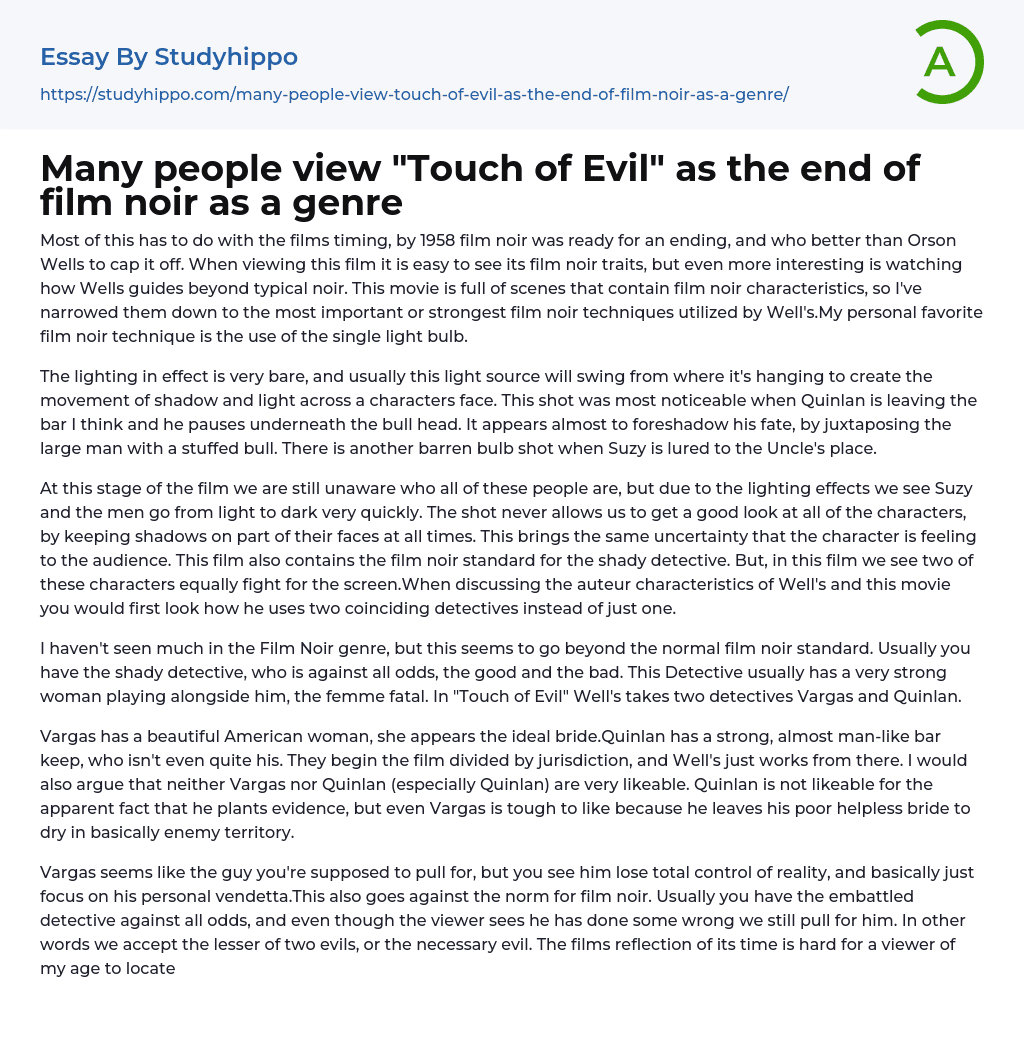

Many people view “Touch of Evil” as the end of film noir as a genre Essay Example
Orson Wells, an ideal filmmaker to conclude film noir in 1958, showcases his talent for surpassing the typical conventions of this genre. While watching this movie, it becomes apparent that film noir elements are present. However, what sets it apart is Wells' ability to go beyond these norms. The film includes scenes that exhibit characteristics of film noir, and I have chosen the most notable techniques employed by Wells. Of these techniques, my personal favorite is his use of a solitary light bulb.
The lighting effect used in the film is simple and minimal. The light source, which is usually hanging, swings to create the movement of shadows and light on a character's face. One instance where this effect is noticeable is when Quinlan is leaving the bar and pauses under the bull head. This shot seems to fores
...hadow his fate by juxtaposing him with a stuffed bull. Another scene with a similar use of bare lighting is when Suzy is lured to the Uncle's place. At this point in the film, we are still unaware of the identities of these characters, but the lighting effects show Suzy and the men transitioning quickly from bright light to darkness.
The shot maintains shadows on the characters' faces throughout, preventing us from fully seeing them. This mirrors the uncertainty experienced by the character, creating the same feeling in the audience. The film adheres to the typical film noir trope of the shady detective, but uniquely showcases two of these characters who vie for attention on screen. When analyzing Wells and this film as an auteur, it is evident that he diverges from the norm by employing two detectives instead
of one. While I am not well-versed in the Film Noir genre, this movie seems to surpass the usual standards. Typically, there is one shady detective who confronts adversities from both the good and the bad.
This Detective typically has a formidable female companion, known as the femme fatal. In "Touch of Evil," Well's introduces two detectives named Vargas and Quinlan. Vargas is joined by a stunning American woman who seems to be the perfect wife. On the other hand, Quinlan is accompanied by a robust barkeep, who possesses masculine qualities, but doesn't fully belong to him. Initially, they are separated by jurisdiction, and from there, Well's narrative unfolds.
I would argue that both Vargas and Quinlan (especially Quinlan) are unlikeable characters. Quinlan's unlikeability stems from his tendency to plant evidence, while Vargas is also difficult to like because he abandons his vulnerable wife in hostile territory. Despite initially being portrayed as the protagonist to root for, Vargas loses control of his sanity and becomes solely focused on his personal vendetta. This departure from the typical film noir narrative further undermines his likeability. In most film noirs, we typically cheer for the embattled detective despite knowing their flaws.
Essentially, we embrace the concept of choosing the lesser of two evils, or accepting a necessary evil. For me, as a viewer of my generation, it is challenging to determine the film's reflection of its era. Initially, I consider a potential link between Quinlan-Vargas and the relationship between the U.S. and U.
S. S. R. is a scenario where two men are compelled to collaborate against a shared adversary, which is crime. This is similar to the scenario in the U.
S.
- The U.S.S.R. was Germany.
The partnership between two factions faces obstacles, leading to their transformation into adversaries. In addition, anxiety emerges regarding the apprehension within our country. The expansive boundaries of our nation contribute to the lack of safety that has probably instilled fear in numerous Americans. This fear could be linked to the consequences of World War II and the commencement of the Cold War, which led to a decline in confidence towards others.
Additionally, it is important to emphasize the importance of the conclusion of the "black film" era, which took place right before Kennedy assumed presidency. It appeared that Americans were ready for a transformation in various aspects.
- Adaptation essays
- Adventure essays
- Adversity essays
- Aging essays
- Alcohol essays
- Barbie Doll essays
- Beauty essays
- Care essays
- Carpe diem essays
- Change essays
- Chess essays
- Chicken essays
- Choices essays
- Contrast essays
- Crops essays
- Development essays
- Dream essays
- Evil essays
- Experience essays
- Family essays
- Farm essays
- Fire essays
- First Love essays
- Focus essays
- Greed essays
- Hero essays
- Holiday essays
- House essays
- Housing essays
- Humility essays
- Humor essays
- Hypocrisy essays
- Integrity essays
- Law of Life essays
- Life Changing Experience essays
- Life Experience essays
- Lifestyle essays
- Limitations essays
- Love Story essays
- Mother Tongue essays
- Motherhood essays
- My Neighborhood essays
- Myself essays
- Mystery essays
- Narcissism essays
- Never Give Up essays
- Nursing essays
- Object essays
- Opportunity essays
- Peel essays



